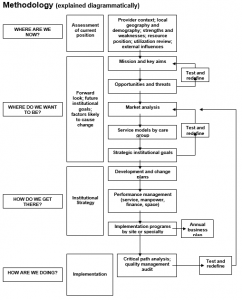Their Role in Healthcare Facility Planning
The complexity and sophistication of decision-making involved in providing healthcare services in an increasingly complicated operating environment requires strategic management. Managing various and multifaceted internal activities is only one aspect of the modern healthcare executive’s responsibilities. The external environment of the service provider poses a second set of challenging factors. This environment includes competitors, suppliers of increasingly scarce resources, government agencies monitoring adherence to an ever-growing number of regulations, and patients, whose preferences must be anticipated and catered to.
A remote external environment also contributes to the general yet pervasive climate in which a healthcare service provider exists. This environment consists of economic conditions, social change, political priorities and technological developments, each of which must be anticipated, monitored, assessed and incorporated into top-level decision making.
However, these influences are often subordinated to the fourth major consideration in executive decision making – the multiple and often mutually inconsistent objectives of the stakeholders of the business: trustees, top managers, employees, communities, customers and country.
To deal effectively with all that affects the ability of a healthcare service provider to grow in a healthy manner, top management needs to design strategic management processes they feel will facilitate the optimal positioning of the organization in its complex environment. Such positioning is possible because these strategic processes allow more accurate anticipation of environmental changes and improved preparedness for reacting to unexpected internal or external demands.
Thus, when a healthcare service provider is planning to build a new healthcare facility, or carry out extensive renovation or additions to one, this facility delivery cycle must be seen as a part of a larger organizational strategic asset management process. From an institutional and business standpoint, buildings are assets that support the missions and programs of the institution.
There is a growing need to understand the overall institutional needs for healthcare service providers in terms of maintenance and capital investment and to develop strategies of how to identify the need accurately.
This process is called strategic asset management.
Strategic asset management is a process for making timely decisions about institutional assets to meet institutional needs.
The management of physical assets is vital to the efficient and effective delivery of high quality healthcare services. Management of assets has in the past been considered largely as a technical activity rather than as a general management responsibility.
An essential prerequisite for the success of strategic asset management is that the planning and management of assets have to be fully integrated within the continuing “management of the whole”. This is most necessary where it occurs least frequently, that is, in the conceptual stages of planning and design, when broad-brush options are being explored.
The major resources available to a healthcare organization or facility that together enable it to achieve its goal of providing quality healthcare services, are as follows:
- PEOPLE. Their energy, skills and dedication.
- FINANCE. Revenue and capital, recurring and non-recurring.
- ASSETS. Land, buildings, plant and equipment.
- INFORMATION. Hard and soft data and its analysis.
The strategic management task involves the blending of these resources within known constraints in order to achieve the institutions objectives.
The key institutional planning questions are:
- Where are we now?
- Where do we want to be?
- How do we get there?
In order to achieve the current and long-range needs of the institution and to secure in a timely manner suitable resources to maintain and augment its assets to support the institutional mission it is necessary to have a strategic asset management plan.
To prepare this plan, the following questions need to be addressed:
- What is the asset base?
- What are the physical conditions of the facilities?
- Are land and other infrastructure adequate for existing and projected functions?
- What capital improvements are required to meet needs?
- What needs are most important?
- Where are funds coming from?
- How should needs be communicated in a manner useful for securing funds?
The methodology for carrying out this study and preparing the strategic asset management plan is represented diagrammatically below.
To audit the facility from a medical point of view, to determine conformance to MCI guidelines and keeping in mind the vision the institution has over the foreseeable future would entail the following activities:
- Audit of existing medical departments and bed strength to determine future needs.
- Audit of existing medical equipment and other infrastructural facilities to determine future needs.
- Operational audit to identify lacunae and determine suitability of existing physical facility adjacencies and suggestions to rectify any shortcomings in the same.
- To prepare a financial plan for a phased implementation of capital improvements in the provision of new facilities, the renovation of existing facilities, the purchase of new medical equipment and/or the upgradation of existing medical equipment.

Pingback: xristougenniatikes stoles